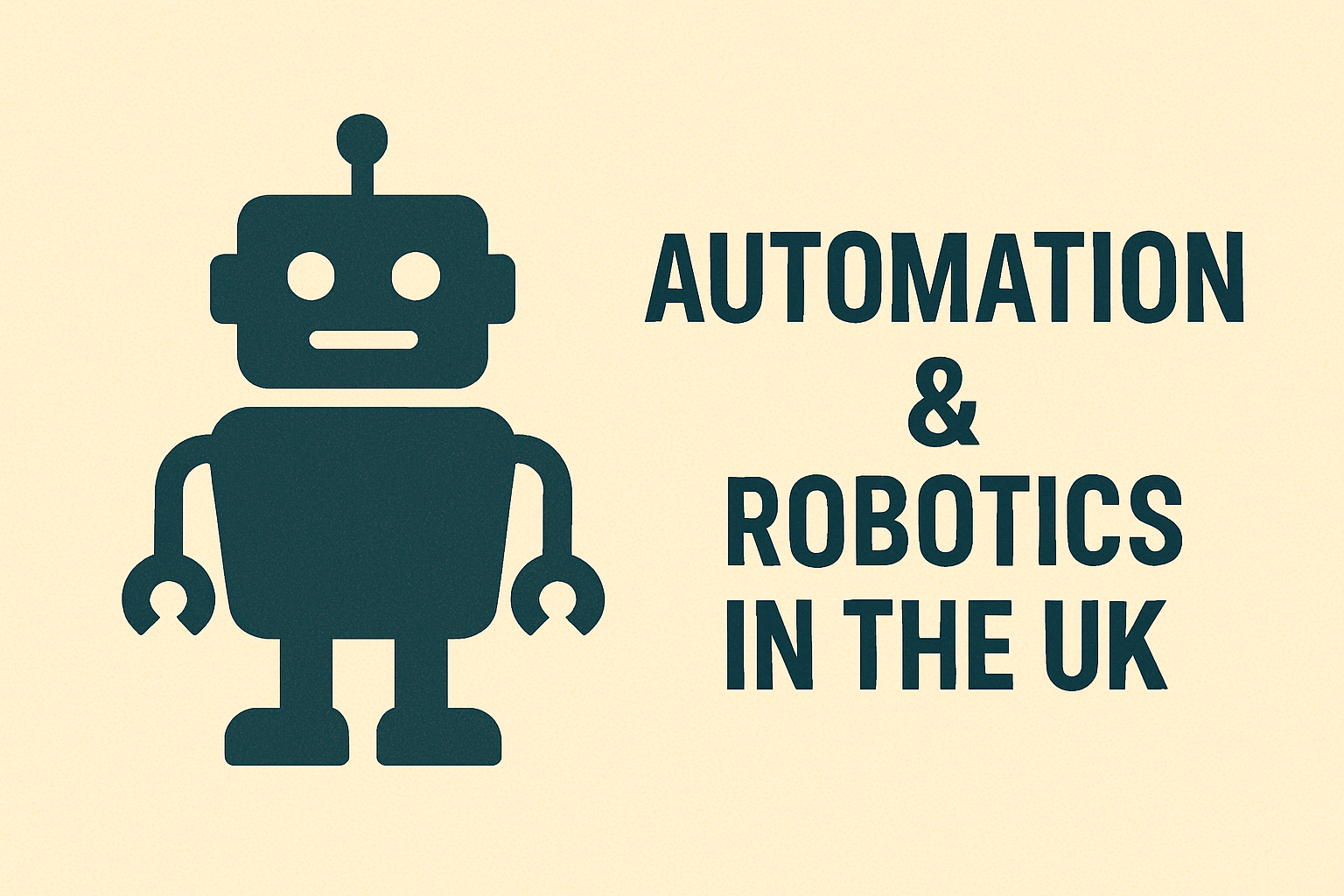Your cart is currently empty!
Automation & Robotics in UK: Streamlining Processes

The United Kingdom is rapidly advancing in the field of automation and robotics. With the rising demand for efficient, scalable, and intelligent operations across industries, businesses are investing heavily in digital transformation. Automation & robotics in the UK are no longer confined to the factory floor—they are reshaping sectors from healthcare and agriculture to finance and logistics.
As digital technologies continue to evolve, automation is becoming a central pillar in driving operational efficiency and economic competitiveness. Robotics, supported by artificial intelligence, cloud computing, and data-driven algorithms, is transforming how tasks are performed, products are delivered, and services are rendered. For UK-based and European businesses, the race is now about adopting these technologies effectively while maintaining regulatory and ethical standards.
The Current Landscape of Automation & Robotics in the UK
Automation & robotics in the UK are thriving thanks to supportive government initiatives, research investments, and commercial adoption. The UK government’s commitment to becoming a science and technology superpower by 2030 includes increased funding for robotic research, AI capabilities, and industrial automation.
Industries are recognising the need to automate repetitive and high-volume tasks. From robotic arms in manufacturing lines to AI-powered chatbots in customer service, automation is making organisations more agile and responsive. The pandemic further highlighted the urgency, accelerating the adoption of automation in response to workforce disruptions, safety concerns, and shifting consumer behaviour.
Impact on Manufacturing and Industrial Operations
The UK’s manufacturing sector has long been a cornerstone of its economy. However, global competition and rising operational costs have compelled manufacturers to modernise. Automation & robotics have emerged as vital tools in reducing costs, increasing precision, and improving production speed.
Smart factories equipped with sensors, robotic machinery, and automated quality control systems are now commonplace. These innovations have made it easier to maintain consistency and reduce human error. The integration of Internet of Things (IoT) and machine learning allows predictive maintenance, ensuring that machinery is serviced before breakdowns occur—reducing downtime and improving overall efficiency.
Revolutionising the Logistics and Supply Chain Sector
The logistics industry in the UK is undergoing a significant transformation due to automation. Robotics is playing a key role in warehouse management, sorting, and delivery operations. Automated guided vehicles (AGVs), drone deliveries, and robotic picking systems have optimised supply chain functions.
In an era of next-day deliveries and real-time tracking, automation enables logistics providers to meet consumer expectations efficiently. Warehouses operated by robotics reduce operational overheads and increase throughput. These innovations are particularly vital during peak seasons or crises when traditional supply chains are strained.
Healthcare Innovation Through Robotics
Automation & robotics are dramatically improving the healthcare landscape in the UK. Robotic surgical systems, automated diagnostic machines, and AI-assisted drug discovery are examples of this transformation. NHS hospitals are increasingly deploying robotic systems for minimally invasive surgeries, which reduce recovery time and hospital stays.
Additionally, robotic assistants are aiding the elderly and individuals with disabilities. These innovations not only improve quality of life but also ease the burden on caregivers and healthcare systems. As the population ages, robotic healthcare support will become increasingly essential.
Boosting Agricultural Productivity
Agriculture in the UK has historically been labour-intensive, but automation is changing that. Robotics is helping farmers monitor crops, manage livestock, and harvest produce with greater efficiency and accuracy. Technologies such as autonomous tractors, drone surveillance, and automated irrigation systems are making farming more sustainable and less dependent on manual labour.
These technologies help tackle challenges such as labour shortages and climate variability. By using AI-based analysis and robotics, UK farmers can optimise yields, reduce waste, and make informed decisions in real-time.
Enhancing Financial Services with Robotic Process Automation
The financial sector has seen a rapid adoption of robotic process automation (RPA) in the UK. Banks and financial institutions use RPA to automate high-volume tasks such as data entry, compliance checks, and fraud detection.
Automation reduces processing time and improves accuracy while freeing up human employees for strategic tasks. In a highly regulated industry, automation also aids in maintaining compliance by providing audit trails and reducing the risk of errors. When integrated with artificial intelligence, these tools can also predict customer needs and personalise financial advice.
For a deeper dive into financial technologies and artificial intelligence, visit Artificial Intelligence in Business.
Automation in the Retail Sector
Retailers in the UK are leveraging automation & robotics to improve customer experiences and streamline backend operations. Self-checkout kiosks, robotic inventory systems, and AI-driven customer service bots are becoming standard across brick-and-mortar and e-commerce platforms.
With changing shopping habits and growing digital expectations, retail businesses are using automation to stay competitive. This includes real-time stock updates, predictive analytics for demand forecasting, and personalised shopping experiences based on user behaviour.
Public Sector and Smart City Initiatives
Automation isn’t limited to private enterprises. The UK government is integrating robotics and automation into public services and infrastructure through smart city initiatives. From AI-based traffic management to robotic waste sorting, these innovations improve service delivery, reduce costs, and support sustainability goals.
Local councils are experimenting with smart street lighting, AI-based public safety systems, and automated utility monitoring. These efforts align with broader digital transformation goals and demonstrate how automation can benefit society at large.
Security, Compliance, and Data Privacy Challenges
While automation & robotics offer clear advantages, they also introduce new risks—especially around cybersecurity and data privacy. As more processes become digitised, protecting sensitive information becomes critical.
The integration of robotics with cloud computing and AI must be compliant with regulations like the GDPR. Failure to safeguard automated systems can lead to breaches, reputational damage, and financial losses. Therefore, organisations must embed security protocols at every stage of automation implementation.
For further insights, explore Cybersecurity & Data Privacy: Protecting Financial Data.
Intersections with Other Emerging Technologies
Automation & robotics do not exist in isolation. Their effectiveness is amplified when integrated with other digital technologies like cloud platforms, blockchain, and financial innovations. For instance, blockchain ensures transparency in robotic supply chain processes, while cloud platforms allow real-time data sharing and analytics.
In finance, automation complements innovations like digital wallets, algorithmic trading, and open banking, all of which are part of the UK’s broader FinTech movement. These synergies create robust digital ecosystems that enhance value across sectors.
You can explore more at FinTech Innovation in UK, Blockchain & Cryptocurrency Regulation, and Cloud Computing Adoption.
The Future of Automation & Robotics in the UK
Looking ahead, the UK is poised to become a global leader in automation and robotics. Continued investment in R&D, training, and infrastructure will determine the pace of adoption. As the technology matures, more SMEs will be able to afford and implement robotic solutions, levelling the playing field and boosting competitiveness.
Education and upskilling will be crucial. The rise of automation necessitates a workforce capable of managing, programming, and innovating around robotic systems. Policies that support lifelong learning and digital literacy will play a critical role in ensuring an inclusive transition.
At the same time, ethical considerations must guide the development and deployment of automation. Clear governance frameworks are essential to ensure that robotics enhances, rather than replaces, human capabilities.
Conclusion: A Transformative Path Forward
Automation & robotics in the UK are revolutionising how industries operate. From manufacturing and logistics to healthcare, agriculture, and finance, these technologies are improving efficiency, reducing costs, and enabling innovation. As automation continues to evolve, it will become a cornerstone of the UK’s digital economy and a key driver of global competitiveness.
By embracing this transformation thoughtfully and strategically, the UK can secure its position as a pioneer in the fourth industrial revolution—ensuring benefits for businesses, workers, and citizens alike.

Mr. Rajeev Prakash
Rajeev is a well-known astrologer based in central India who has a deep understanding of both personal and mundane astrology. His team has been closely monitoring the movements of various global financial markets, including equities, precious metals, currency pairs, yields, and treasury bonds.
